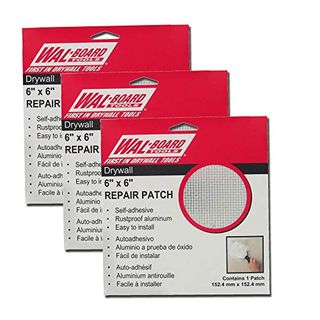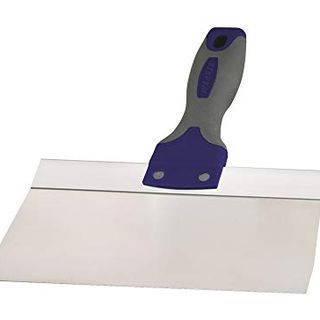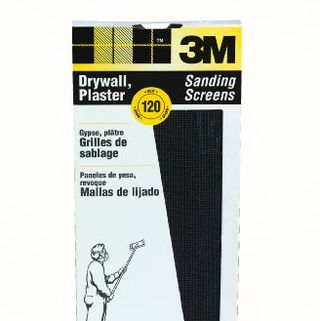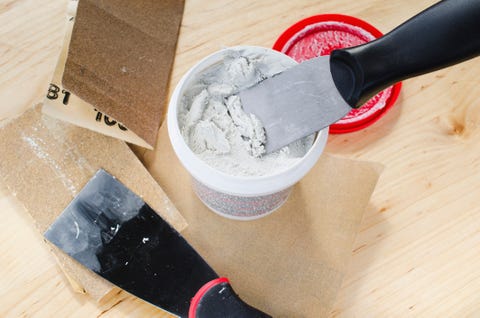How To Repair A Corner Wall
If you find yourself staring at damaged walls and ceilings in your home, it might be time for a little TLC and an update. The interiors of most homes are covered with gypsum wallboard, which is commonly known equally drywall, or by its trade proper name, Sheetrock. Drywall is durable to a degree, but it can only take so much before you outset to see holes, cracks, and dents—peculiarly if you've got toddlers or pets running around.
⚒️ You like fixing stuff. So exercise we. Allow's DIY some cool $h*t together.
Fortunately, most drywall damage can exist repaired rapidly and easily. All you need are some basic tools, the right materials, and a few tricks of the trade. This footstep-by-step DIY guide volition show you how to repair drywall—from doorknob harm, to cracks under the window, all the way to saggy ceilings—but offset, we need to get over some safety measures.
⚒️ Tips To Stay Safety While You Repair Drywall
one) Lift Carefully. When patching extensive damage, it's best to buy total 4-by-8 foot sheets of drywall, and and then cut them down to size as needed. Just, exist advised that a full canvas of standard 1/2-inch drywall weighs nearly 54 pounds.
Drywall sheets are awkward to lift and carry, so you'll want to avoid straining your back. If possible, always piece of work with a helper and call back to elevator with your knees, not your back. Also, be careful when leaning drywall sheets against stuff. If a sheet should autumn over, it could severely hurt someone, peculiarly a kid or pet.
2) Empty Bucket Warning. Premixed joint compound comes in various size buckets, which are handy to employ around the house and yard once they're empty. However, five-gallon buckets pose a serious threat to toddlers. The buckets are just the right height that if a small child leans over the edge, they tin tumble in headfirst and notice themselves unable to scramble out. Therefore, if you use the bucket for conveying h2o, never leave the saucepan unattended, even if information technology's holding just a few inches of water. And, never get out buckets outdoors where they tin can fill with rainwater, creating a potential drowning hazard.
If you apply the buckets primarily for carrying and storing tools, gardening supplies, and other dry goods, eliminate the possibility of a kid drowning by drilling drainage holes through the side and lesser of the bucket.
3) Clean Up the Dust. Making drywall repairs typically requires sanding articulation compound to produce a smooth, unblemished surface. Nevertheless, joint compound grit is a respiratory irritant that contains super-fine gypsum and silica particulates. When sanding joint compound, always wear a dust mask, or better however, a dual-cartridge respirator, to protect your lungs.
It's also a skilful thought to spread a drop cloth on the flooring where yous're sanding. When done sanding, wipe the dust off the driblet fabric with a clammy sponge, so make clean the surrounding areas with a shop vacuum fitted with a HEPA filter. One time the air has settled, terminate up by vacuuming. This 2-step cleaning is necessary because most household vacuums can't capture super-fine sanding grit, and volition simply blow information technology back into the air.
⚒️ Know What Compound You Need
The ii most common types of premixed drywall compounds—also known as spackle—are lightweight and all-purpose. The lightweight product weighs near one-tertiary less than all-purpose, it dries more quickly, and takes less attempt to sand smoothen. All-purpose compound dries harder and typically costs less.
Both types are piece of cake to apply and have a shelf life at room temperature of about 9 months. If yous have drywall damage in several rooms, buy a five-gallon bucket of compound. For smaller repairs, something similar this volition suffice.
Note that dry out-mix articulation compound is as well available, which comes in pulverisation form. Information technology must be mixed with water to the proper consistency prior to awarding. Dry-mix chemical compound is more affordable than the pre-mixed varieties, but pre-mix chemical compound is easier and quicker to employ for DIY repairs.
⚒️ Problem 1: Doorknob Damage
Step 1: I of the virtually mutual drywall repairs occurs when a door is swung open up a picayune too forcefully and the doorknob punches a hole through the drywall. The simplest way to prepare the pigsty is with a peel-and-stick repair patch. The patch consists of an adhesive-backed aluminum screen that'due south reinforced by fiberglass mesh. Simply peel off the protective backing and printing the patch over the hole.
Footstep 2: Use a 4- or 6-inch-wide drywall knife to utilise joint compound over the patch. Be sure to utilise plenty pressure to force the compound through the mesh. Subsequently the compound dries, sand lightly and apply a 2nd, thinner coat of chemical compound, making certain to extend information technology a few inches across the first coat. Echo a third and final fourth dimension. When dry, sand lightly, so prime and paint.
⚒️ Problem 2: Crumpled Corner Dewdrop
Step ane: When two sheets of drywall meet at an outside wall corner, they're protected by an L-shaped metal strip called a corner bead. Corner bead is nailed over the corner and then concealed by 2 or three layers of joint compound. Metallic corner dewdrop is pretty tough stuff, but it's not indestructible. It tin get dented through whatsoever number of activities, including run-ins with the vacuum cleaner, a kid flinging a toy, or when moving furniture. The good news is that, commonly, but a small section of the corner dewdrop gets damaged, making the repair much simpler.
Begin by using a hacksaw to cut through the corner bead approximately 2 inches above and beneath the damaged section. Adjacent, accept a utility knife and cutting along each vertical edge of the corner dewdrop, making sure you slice through the paint and joint chemical compound.
Step 2: Pry the severed piece of corner bead from the wall using a sparse pry bar and direct-blade screwdriver. Effort not to damage the surrounding drywall surfaces. Now, use aviation snip to cut a new piece of corner bead to supervene upon the damaged section.
Step 3: Ready the new piece into place and fasten it with ane½-inch-long drywall nails, which have very thin, flat heads that are easier to conceal with joint compound than drywall screws.
Step 4: Utilise two to three coats of articulation compound, making certain to sand between coats. Spread the final glaze with an 8-inch drywall knife. When washed, prime number and paint to friction match the walls.
⚒️ Trouble 3: Creeping Cracks
Step ane: Vertical drywall cracks will oftentimes appear above and below windows and doors. These hairline cracks are usually caused by lumber shrinkage and settling in the house frame. To repair the cracks, first past using a sanding sponge to sand the crevice shine. After sanding, vacuum the crevice to remove all loose dust and debris.
Step 2: Next, apply a narrow putty pocketknife to apply a thin coat of joint compound to the crack. Await for information technology to dry, so sand it smooth. Repeat, applying a second thin glaze.
Pace iii: To dissuade the scissure from reappearing, spray the repair with a thin coating of rubberband scissure encompass-upward, such every bit Skillful-Bye Cracks.
⚒️ Problem 4: Nails That Go Pop
Step 1: Nail and screw pops are also caused by lumber shrinkage. To fix a popped smash or screw, start by twisting the tip of a utility knife into the wall to carve away the joint compound from the fastener caput.
Step 2: Use a screwdriver to tighten the spiral, driving it well beneath the surface. If it's a popped nail, use a hammer and boom ready to tap it in deeper. If it feels equally if the nail isn't hitting solid wood, yank it out with pliers and drive in a drywall screw, making sure you lot hit the middle of the wall stud or ceiling joist.
Step iii: Hide the repair using a drywall knife to use three thin coats of lightweight joint compound. Sand between coats, then prime number and paint.
⚒️ Problem 5: Saggy Textured Ceilings
Footstep 1: H2o impairment will usually stain a drywall ceiling, but in some extreme cases, the drywall will actually sag down from the joists. This is a particularly tricky repair on a textured ceiling. Kickoff by using a hand-sanding pad equipped with a sanding screen to remove the texture and smooth out the expanse.
Step 2: Next, printing the drywall upwards tight against the joist and secure it forth the seam with drywall nails or screws driven into the eye of the joist.
Footstep 3: Water stains will often bleed through standard primer. To prevent the stains from reappearing, castor on a glaze of primer that is specifically formulated to block out the toughest stains.
Step 4: To blend in the repaired area with the surrounding textured ceiling, utilize a thick-nap roller to apply a thick mixture of drywall compound, thinned with a little water.
Step 5: Before the thinned drywall compound dries, add texture to the ceiling with a short-handled brush. If your ceiling has a popcorn texture, try concealing the repair with popcorn texture in a spray can.
⚒️ Problem half-dozen: Loose Inside-Corner Tape
Step ane: Seams between sheets of drywall are hidden backside paper drywall tape and several thin layers of articulation compound. Occasionally, the paper tape will pull loose and peel upwards, especially in bathrooms where the tape is repeatedly exposed to hot, moist air. And this problem oftentimes occurs at within wall corners.
While it'southward tempting to only glue downward loose tape, it's best to cutting it out with a utility knife and supercede it with a new slice of tape. Afterwards cutting abroad the loose record, apply a thin bed of drywall compound to each wall in the corner.
Step 2: Next, cutting a new piece of paper tape to length, fold it lengthwise along its center crease, and printing it into the wet joint compound.
Step three: Y'all can printing the tape into the chemical compound and smooth it out with a four-inch knife, but using an inside-corner knife makes the chore much easier. This specialty tool smooths both sides of the within corner at the same time.
⚒️ Problem seven: Patching Large Holes
Step 1: To repair a large hole in drywall, first describe a square outline around the hole using a 24-inch level. Every bit you mark the four lines, exist sure to heart one vertical line on the center of a wall stud.
Step 2: Cut 3 sides of the foursquare using a drywall saw, which is as well called a jab saw because you beginning cut by jabbing the saw'due south pointed tip through the drywall. Lift away the debris as you cutting to continue information technology from falling into the wall crenel.
Step 3: Remove the drywall on the remaining side of the outline past using a utility knife to cut down the center of the stud.
Stride iv: Cut a one-by-four human foot pine board half-dozen to eight inches longer than the square opening in the wall. Squeeze some structure agglutinative onto the ends of the lath.
Footstep five: Skid the one-past-4 into the hole with the glued surface facing the dorsum of the drywall. Position the board so it extends into the opening past at to the lowest degree 1½ inches. Secure the board with two clamps.
Footstep vi: After the adhesive dries, cutting a drywall patch to loosely fit into the hole. Apply some structure adhesive to the exposed surface of the one-by-four, so press the patch into place and secure it to the stud and to the ane-by-4 backing board with 1¼-inch drywall screws.
Step 7: Wipe down the wall and drywall patch with a slightly dampened sponge to remove whatever dust. Side by side, apply adhesive-backed fiberglass mesh drywall tape over the 4 seams of the patch. Overlap the tape at the corners for maximum strength, and center each piece direct over a seam. Firmly press downward the tape for good adhesion.
Step 8: Use a 4-inch drywall knife to employ the first layer of articulation compound over the record. Allow the compound to dry out overnight.
Step ix: Smooth the dried compound with a paw-sanding pad fitted with a sanding screen.
Footstep 10: Use an eight-inch knife to apply several skim coats of joint compound over the repair, making each one slightly larger than the preceding one. Sand the last coat shine with 220-dust sandpaper. Finish by rolling on a coat of primer, followed by two topcoats of paint. And notation that, in some cases, it might be necessary to pigment the unabridged wall to ensure the patch is undetectable.
This content is created and maintained by a third political party, and imported onto this folio to aid users provide their email addresses. You may exist able to find more information well-nigh this and similar content at piano.io
Source: https://www.popularmechanics.com/home/interior-projects/how-to/a185/easy-drywall-repair/






0 Response to "How To Repair A Corner Wall"
Post a Comment